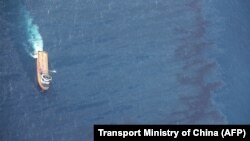Oil slicks on the water surface around a sunken Iranian tanker in the East China Sea are expanding, Chinese authorities reported, raising environmental concerns.
China’s State Oceanic Administration said that it had found an 18-kilometer-long slick east of where the vessel sank, and another slick that was almost 15 kilometers long southwest of the site.
Another slick with a radius of about 5 kilometers was spreading north from the site, it said.
The Shanghai Maritime Search and Rescue Center has stopped large-scale efforts to find the tanker's 29 missing crew members, who are now presumed dead, and is starting efforts to clean up the water's surface, China National Radio said.
The World Wildlife Fund said the fuel leaking from the tanker is toxic to marine mammals, fish, sea turtles, and seabirds and that authorities are in a "race against time" to contain the slick.
"The oil puts many sea creatures in danger," Ma Jun, from Beijing's Institute of Public and Environmental Affairs, told dpa.
Greenpeace said the area is a spawning ground for bluefin leatherjacket and swordtip squid, and the winter habitat of blue crab, chub mackerel and yellow croaker.
But Greenpeace said that because most of the light condensate fuel the tanker was carrying appeared to have burned off in the week before the tanker sank on January 14, the remaining leaks of fuel should not result in the sort of thick, black oil slick typical of the most environmentally disastrous spills.
Any contaminated sea life caught by fishermen and then sold for consumption could have health consequences for people, warned Lin Boqiang, the Global Times cited a Chinese environmental expert as saying.
The oil spill is likely to be carried northward by the wind and currents, China's maritime administration said. However, it said the complexity of the currents make it hard to predict exactly where it will drift.
Japan's environment ministry has said it doesn't see much chance that the spill will reach the shores of Japan, where it could do the most environmental damage.
South Korea is north of the site where the tanker sank, but a coast guard official from the country played down the chances of the slick reaching the peninsula, noting it was about 600 kilometers from Jeju Island, the nation's southernmost island.
The tanker, named Sanchi, was carrying about 136,000 tons of condensate when it collided with a Hong Kong freighter on January 6, approximately 300 kilometers east of Shanghai.
After the tanker sank, the Iranian Transport Ministry said there was no hope of finding survivors. The tanker set out on its journey to South Korea from Iran with 30 Iranian and two Bangladeshi crew members. Three bodies were found during rescue efforts.





